| 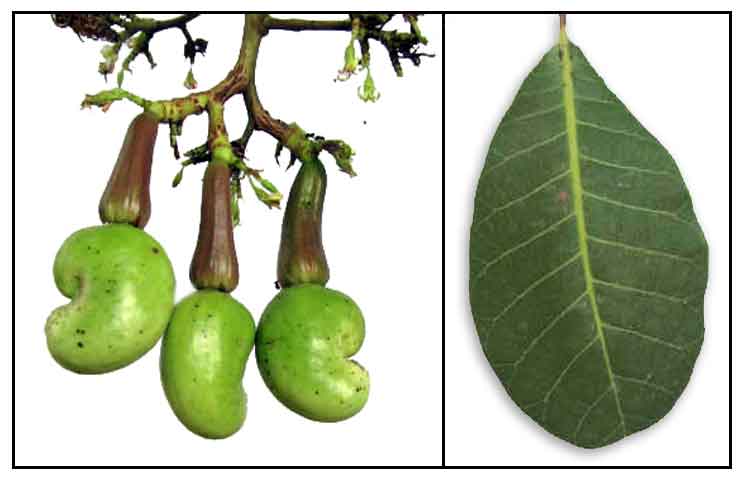 Gen info Gen info
- Anacardiaceae, commonly known as the cashew family or sumac family, is a family of flowering plants, including about 83 genera with about 830 known species. Anacardiaceae include numerous genera, several of which are economically important, notably cashew, mango, Chinese lacquer tree, yellow mombin, Peruvian pepper, poison ivy, poison oak, sumak, smoke tree, marula, and cuachalalate. (18)
- Etymology: The English name derives from the Portuguese name for the fruit of the cashew tree: caju, also known as acaju, which is from the Tupi word acaju, literally meaning "nut that produces itself". The genus name Anacardium derives from Greek prefix ana- (up, upward) and cardia (heart), and the Neo-Latin suffix -ium, probably referring to the heart-shaped fruit. (Anacardium was earlier used to refer to Semecarpus anacardium, the marking nut tree, before Carl Linnaeus transferred it to the cashew; both plants belong to the same family.)The species epithet occidentale refers to the Western or Occidental world. (1)
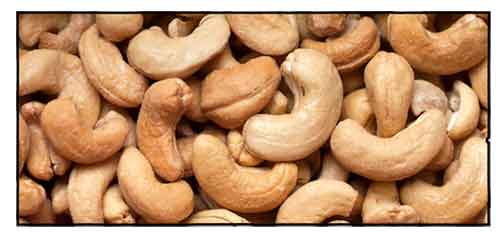 Botany Botany
• Kasuy is a small tree with a usually small
and crooked trunk. Leaves are simple, smooth, alternate, ovate or obovate,
10 to 20 centimeters long, 7 to 12 centimeters wide, with slightly rounded, emarginate apex. Flowers
are small, 5 to 6 millimeters in diameter, crowded at the tips of the branches, and yellow to yellowish-white, the petals usually with pink stripes. The fruit, a nut, is ash-colored, kidney-shaped and about 2 centimeters long. The mesocarp is soft, corky, and oleoresinous; and the epicarp is leathery. Seed is kidney-shaped. Torus (receptacle) is
fleshy, juicy, yellowish, pear-shaped, and 5 to 7 centimeters long.
Distribution
- Throughout the Philippines in settled areas at low and medium altitudes, cultivated, and in some places, naturalized, or at least persistent after abandoned cultivation.
- Introduced from tropical America in the early colonial period.
- Now pantropic.
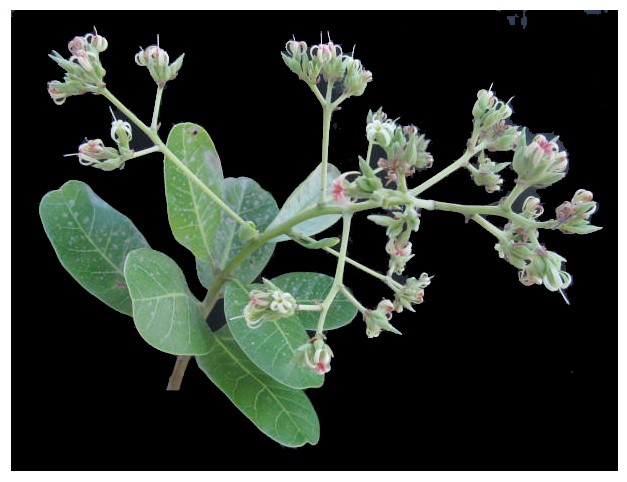 Constituents Constituents
• Kernel yield of fixed oil, 45-47.2%;
starch; sitosterin, 8%; cardol; anacardic acid; lignoceric acid.
• Oil contains linoleic acid, 7.7%; palmitic acid, 6.4%; stearic acid, 11.24%; lignoceric acid, 0.5%; and sitosterin.
• Plant yields two oils: (1) a light-yellow oil from the pressed kernels, of which the finest quality is comparable to almond oil; and (2) Cardole, from the shell of the nut, an acrid and powerful fluid useful for preserving carved wood, books, etc. against white ants.
• Cashew nut oil yields: oil, 16.12%; moisture, 2.37%; ash, 3.94%; protein, 31.67%; nitrogen, 5.70%; crude fiber, 0.44%; and carbohydrates, 45.46%.
• Bark yields a gum also obnoxious to insects.
•The kernel contains 7.6-16% moisture, 18-24% protein, 43-57%
fats,19-21% carbohydrates.
• Anacardic acids, the by-product of cashew processing, have medicinal
uses.
• Pericarp (shell) of the fruit yields a toxic principle, cardol oil, and anacardic acid.
• Trunk yields a gum, anacard-gummi or cashew gum, with arabin, used similarly as gum arabic.
• Wood yields catechin.
• A study yielded anacardic acid, cardanol, cardol, and 2-methyl
cardol. Immature nut oil contains triglycerides, fatty acids, alkyl-substituted
phenols and cholesterol. The main constituents of the free fatty acids
were palmitic and oleic acids.
• Study of aqueous and methanol extracts of leaf, bark and root of cashew yielded bioactive principles, i.e., tannin-15.38mg/g, total polyphenolics-2.00, alkaloid-39.90 and oxalate-8.13. (30)
• Study of aqueous and ethanol extracts of leaves yielded carbohydrates, proteins, saponin glycosides, flavonoids, alkaloids, tannins, and phenolic compounds.
• Nutrient analysis of organic whole raw cashews per 100 g: (Proximates) energy 567 kcal, protein 16.67 g, total lipid (fat) 43.33 g, carbohydrate by difference 30.00 g, total dietary fiber 3.3 g, total sugars 6.67 g; (Minerals) calcium 67 mg, iron 10 mg,
sodium 0; (Vitamins) vitamin C 0, vitamin A 0; (Lipids) total saturated fatty acids 8.330 g, total trans FA 0, cholesterol 0. (49)
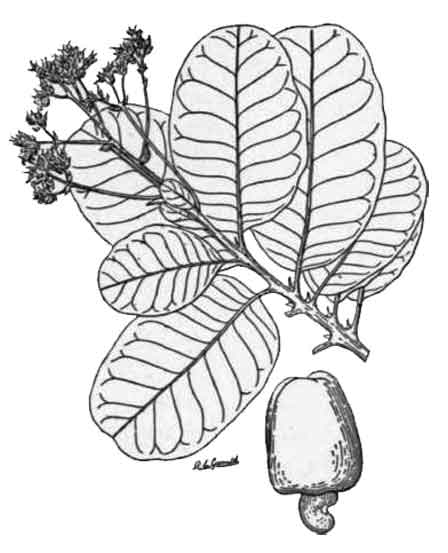 Properties Properties
• Kasuy is a very peculiar fruit consisting of two parts: Below, a large, soft, yellow, fleshy, juicy, pear-shaped structure which is derived mostly from the receptacle of the flower, edible, with the characteristics of a fleshy fruit, slight sweet, at times very acrid and irritating to the throat and tongue. Above, the kidney-shaped nut, the kernel of which has an excellent flavor when roasted.
• Phenolic content with antioxidant activities.
• Bark considered alterative.
• Fruit considered acrid sweet, digestible, aphrodisiac, anthelmintic, rubefacient.
• Juice of fruit considered diuretic, sudorific, and antisyphilitic.
• Bark and leaves considered astringent.
• Fumes arising from the nuts during roasting may be irritating to the face, nostrils, and throat. The oil exuding from the nuts is very caustic and may cause skin brown marks like warts, swelling, and inflammation.
• Studies have suggested antioxidant, anti-inflammatory, antibacterial, hypoglycemic, anti-acetylcholinesterase, antidiabetic, nephroprotective, antitumor, antiatherogenesis, antivenom, anthelmintic, hypocholesterolemic, larvicidal, antidiarrheal, antidepressant, hemostatic, aphrodisiac, hypotensive, wound healing, antifungal, antiarthritic, antiedematogenic properties.
Parts used
Bark, leaves, oil, and ripe
fruit.
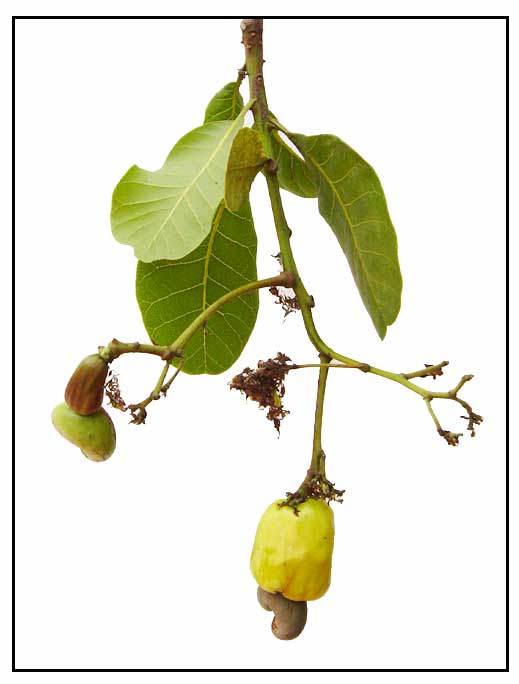 Uses Uses
Edibility / Nutrition
- Ripe fleshy portion of fruit may be eaten; sweet, although sometimes acrid and irritating to the throat and tongue. Often eaten with salt. Wine is made from it.
- The kernel has an excellent flavor when roasted, makes an savory candy nut and a popular snack food.
- Young leaves eaten as vegetable, a fair source of calcium and iron.
- In Brazil, popular drinks include fresh and processed cashew apple juice. (57)
Folkloric
• Astringent and
mouth wash: Gargle dilute infusion of bark and leaves and retain in
mouth for a few minutes to relieve toothache, sore gums, or sore throat.
Do not swallow.
• Receptacle boiled in sweetened water used by Filipinos as remedy for dysentery.
• Bruised nut used as irritant to cause abortion.
• Decoction of bark used for diarrhea, syphilitic swelling of the joints, and for diabetes.
• Bark, rich in gallic acid, used as decoction against aphthae and mouth ulcerations.
• Bark and leaves considered astringent; infusion used to relieve toothaches
and sore gums, and as a lotion and mouthwash, also used internally for dysenteric conditions.
• Spirit distilled from the fruit is considered rubefacient. Used as diuretic.
• Pear-shaped receptacle eaten as cure for scurvy.
• Oil from pericarp used as anesthetic in leprosy and psoriasis, and as a blister for warts, corns, and ulcers. Also applied to cracks in the feet. In the Philippines, oil used as a powerful escharotic and vesicant.
• Tincture of pericarp used as vermifuge in Europe.
• Kernel oil is a mechanical, as well as chemical, antidote for irritant poisons. Also, it is a good vehicle for liniments and other external applications.
• Oil from the kernel is nutritious and emollient; used as demulcent in form of an emulsion.
• Juice of receptacle is acid and astringent; used for uterine troubles and dropsy.
• In Guyana, decoction of bark used
as antidiarrheal. Powdered seeds used as antivenom for snake bites.
Nut oil used as antifungal and for healing cracked heels.
• In Sierra Leone, Aku people use the young leaves for dysentery, diarrhea, piles, etc.
• In western Nigeria, used for arthritis
and other inflammatory conditions. In some parts of Nigeria, bark used to treat diabetes.
• In Cameroon traditional medicine, used for diabetes and hypertension.
• In Malay folklore medicine, decoction of vein and leaves used to lower blood pressure of diabetic patients.
• In Portugal, herbal preparation from stem bark used for treatment of diabetes. (59)
• Wayapi tribe of Guyana use leaf and bark decoction for diarrhea remedy and as douche for vaginal discharge. In Brazil, used for treatment of diabetes, weakness, muscular debility, urinary disorders, asthma, eczema, psoriasis, scrofula, venereal disease, leishmaniasis, impotence, and syphilis-related skin disorders. (60)
Others
- Repellent: Oil from the pericarp effective against white ants. Bark yields a gum that repels insects.
- Oil from the kernel is a chemical antidote for irritant poisons and
a good vehicle for liniments and other external applications.
- Cardole, the oil from the shell of the nut, is effective for preserving
wood and books.
- Resin / Gum: Cardanol, from anacardic acid, is used for resins, coatings and frictional
materials. Resin used as varnish. Gum used as adhesive for woodwork and bookbinding
- Fodder: Cake remaining after extraction of oil from leaves serves as animal food. Seed coat used as poultry feed. (54)
- Fuel: Used for firewood and making charcoal. (54)
- Fiber: Pulp from wood used for making corrugated and hardboard boxes. (54)
- Dyestuff: Bark yields an acrid sap used as indelible ink in marking and printing linens. A 3-5% tannin is used in the tanning industry.(54)
- Alcohol: Slightly fermented juice can be distilled to make strong alcoholic drinks. In India, juice makes a brandy called "fenni" and in Tanzania,
"konyagi," a product similar to gin. (54)
Studies
• Antibacterial: (1) Anarcardic acids effective against gram-positive
bacteria, used in vivo for tooth abscesses. (2) In vitro study of different fractions of leaf extract of AO showed Staph aureus and P aeruginosa to be most sensitive to the chloroform extracts. (3) Study confirmed the traditional claim of false fruit of Anacardium occidentale as an antimicrobial. (11) (15)
• Anti-Inflammatory / Stem- Bark: Potentiation
of the anti-inflammatory effect of Anacardium occidentale (Linn.) stem-bark
aqueous extract by grapefruit juice: Study results showed the plant
extract possess anti-inflammatory activity, supporting folkloric use
of the plant for arthritis and other inflammatory conditions. (2)
• Hypoglycemic: The experimental
animal study showed AO extracts to possess hypoglycemic activity supporting
its folkloric use. Although the mechanisms are highly speculative, the
hypoglycemic effect of the plant extracts could be due, in part, to
their terpenoid and/or coumarin contents. (3)
• Antioxidant: Effects
of immature cashew nut-shell liquid (Anacardium occidentale) against
oxidative damage in Saccharomyces cerevisiae and inhibition of acetylcholinesterase
activity. Study showed immature cashew nut-shell liquid (iCNSL), a source
of unsaturated long-chain phenols, and may have a potential role in
protecting DNA against oxidative damage. (4)
• Antioxidant / Anti-acetylcholinesterase
Activity Study on immature cashew nut shell liquid showed
antioxidant and anticholinesterase activities. Study yielded anacardic
acid, cardanol, cardol, and 2-methyl cardol.
• Brain and Kidney Benefits:
Microstructural study of the effect of ethanolic extract of
Cashew stem bark of Anacardium occidentale on the Brain and Kidney of
Swiss albino mice showed no toxic effects with enhancement of functions
and suggests a potential for its use in certain brain and kidney ailments. (5)
• Antibacterial / Periodontal Benefit:
Activity of Some Thai Medicinal Plants against Porphyromonas
gingivalis: In a study that screens Thai medicinal plants for antibacterial
activity against Porphyromonas gingivalis, AO was one of several tested.
Of the studied plants, AO bark and leaves showed the best inhibition
of Porphyromonas gingivalis and Terminalia bellerica and suggests its
potential for use in therapy. (6)
• Anti-diabetic:
Protective role of Anacardium occidentale extract against streptozotocin-induced
diabetes in rats: Study showed a protective role of AO extract
against the diabetogenic action of STZ. (7)
• Antioxidant: Comparisons
between the Antioxidant Activities of the Extracts of Anacardium occidentale
and Piper betle: The methanolic extract of AO can be an alternative
source of polyphenolics with potent antioxidant activities. (8)
• Acute and Subchronic Toxicity Studies: Study of leaf hexane extract of A. occidentale in mice showed no toxicity on acute administration with doses less than 6 g/kg. At high doses, signs of toxicity were asthenia, anorexia, diarrhea, and syncope. Liver and kidney parameters were significantly abnormal with correlating histopathological changes. Study concludes toxic effects of AO hexane leaf extract occurred at higher doses than those use in Cameroon folk medicine.
• Antihyperglycemic / Renal Protective: Study showed the efficacy of AO hexane extract in reducing diabetes-induced functional and histological alterations in the kidneys. (9)
• Antitumor Activity: Cashew gum polysaccharide, combined with water soluble, branched ß-galactose and other oligosaccharides and proteins exhibited an antitumor activity with a high inhibitory activity against an implanted sarcoma 180 solid tumor in mice. (10)
• Antioxidative / Anti-Atherogenesis: Study suggested the aqueous extract of AO possessed antioxidative properties and attenuates the initial stage of atherogenesis in vitro possibly through inhibition of NF-kB activation. (12)
• Anti-Ophidian: Study evaluated the ability of A. occidentale bark extract to neutralize enzymatic and pharmacological effects induced by Vipera russelii venom. Results suggest it may be used as an alternative treatment to serum therapy and may also be a rich source of potential inhibitors of hydrolytic enzymes involved in several physiopathological diseases. (13)
• Gum as Gelling Agent: Study indicated the extracted mucilage may be a good source of a pharmaceutical adjuvant, specifically as a gelling agent. (14)
• Toxicity Screening / Hypocholesterolemic Effect:Study in hypercholesterolemic rabbits evaluated the toxicity properties and hypocholesterolemic effects. Aqueous extract was found to be non-toxic and possess cholesterol-lowering effects. (16)
• Anthelmintic: AC was evaluated for anthelmintic activity against earthworm Pheretima posthuma. Both alcohol and aqueous extracts of the whole plant exhibited significant anthelmintic activity at highest concentration of 500 mg/ml. Albendazole was the reference drug. (17)
• Aphrodisiac / Seed Oil: Seed oil yielded saponins, alkaloids, flavonoids, steroids, and terpenoids.
The seed oil, test on male albino rats for sexual behavior, showed increase in mount and frequency of intromission, with decrease in mount latency. Results suggest the seed oil may be used to manage impotency in male humans. The seed shell oil, tested for toxicity, can be used to kill mice by application on foods eaten by mice. (20)
• Gum as Tablet Binder: Seed evaluated the binding efficacy of cashew nut tree gum in tablet formulation (paracetamol) compared with standard binders such as acacia of polyvinyl pyrrolidone (PVP K-30). Results suggest cashew nut tree gum can be used as an alternative binder with good mechanical strength and dissolution profile. (21)
• Differences in Constituents and Medicinal Properties of Different Extracts: Folkloric use of herbals involves the use of plants without the isolation of particular phytochemicals, hoping for synergy of combined substances and dilution of toxicity, while modern pharmacy prefers single ingredients for dosage quantification, requiring detailed analysis of phytochemical constituents. In this study with guava, the highest concentration of bioactive principles were detected in ethanol extracts. The study justified the use of alcohol in folkloric extraction. (22)
• Improved Renal Clearance: Study investigated the effects of a crude ethanolic extract of stem bark on renal clearance of Sprague Dawley rats. Results showed improvement of renal clearance on high dose of EAO. The study does not confirm or suggest the possible mechanisms of increased renal clearance. (23)
• Antifeedant / Anthelmintic: Study compared the antifeedant and anthelmintic activities of crude extracts of shells of Anacardium occidentale with the activity of Azadirachta indica, a commercial standard. Results showed the test extracts of A. occidentale in petroleum ether, dichlormethane:methanol showed better activities. Phytochemical analysis yielded phenols viz., cordol, cardanol, and anacardic acid. (24)
• Hypoglycemic / Antioxidative / Leaves: Study of leaf extract in a diabetic rat model showed hypoglycemic activity. Observations suggest the extract could improve and protect the islet Langerhan cells from oxidative degeneration. The preventive effects may be due to inhibition of lipid peroxidation by its antioxidant properties. (25)
• Larvicidal / Nut Shell Liquid: Study reveals Aedes aegypti larvae and pupae are highly susceptible to 12 ppm CNSL (cashew nut shell liquid). Results suggest further studies conducted in different ecosystems to observe the larvicidal effect of CNSL on different vectors of malaria, dengue, and filariasis, as CNSL is is cheap, easily available, eco-friendly, non-toxic, and biodegradable. (26)
• Hypoglycemic / Stem Bark Extract: Study of stem bark extract in STZ-induced diabetic rats showed antihyperglycemic property with a positive effect on weight gain. (27)
• Anthelmintic / Antifeedant: Study evaluated crude extracts of shells of Anacardium occidentale for antifeedant and anthelmintic activities. Test extracts showed better activity compared to A. indica. The addition of piperine to the formulation significantly enhanced the anthelmintic activity. (28)
• Antimicrobial / Cosmetic Formulation: Study evaluated the extract of A. occidentale against S. aureus and S. epidermis and then developed cosmetic formulations from those extracts. Although promising, the formulation gradually darkened when stored at temperatures between 40º and 60ºC. (29)
• Anthelmintic: Study evaluated alcohol and aqueous extracts from whole plant of A. occidentale for anthelmintic activity. Both extracts showed significant anthelmintic activity at highest concentration of 500 mg/ml. Albendazole was used as standard reference. (31)
• Negative Effect on Pregnancy Outcome: Study evaluated the effect of a leaf extract of A. occidentale on reproductive outcome of Wistar rats. Study revealed low birth weight and low crown-rump length effect, suggesting serious implications with consumption of leaf extract during pregnancy. Low birth weight has a major influence on neonatal morbidity, neurocognitive deficiencies, neurobehavioral effects and mortality. The author warns that the extract should not be taken by pregnant women. (32)
• Antibacterial / Leaf and Bark: Study evaluated the inhibitory effect of a methanolic extract of leaf and bark of Anacardium occidentale against Staphylococcus aureus and Streptococcus mutans from burn and dental caries patients. The extracts inhibited all clinical isolates, and the leaf extract inhibited to a higher extent than the bark. (33)
• Anti-Diabetic / Increased Glucose Uptake: Study evaluated the anti-diabetic properties of cashew plant parts using differentiated C2C12 myoblasts and rat liver mitochondria. Results showed the extract and its active component, anacardic acid, stimulated glucose transport into C2C12 myotubes in a concentration-dependent manner. Also, the dysfunction of mitochondrial oxidative phosphorylation may enhance glycolysis and contribute to increase glucose uptake. (34)
• Antidiarrheal / Leaf Extract Enriched with Zinc: Study evaluated the antidiarrheal activity of zinc, aqueous leaf extract and zinc enriched leaf extract. Results showed good antidiarrheal effect in all three formulations but the cashew leaf extract enriched with zinc exhibited the best antidiarrheal activity. (35)
• Cytoprotective / Testes of STZ-Induced Diabetic Rats / Improved Spermatogenesis: Study evaluated the protective effects of methanolic leaf extract on testes of STZ-induced diabetic rats. Results showed significant increases in levels of testosterone, FSH and LH. AOLE improved the structural integrity of the testes, promoted spermatogenesis, and improved the profile of reproductive hormones. (36)
• Anti-Hyperglycemic / Beta Cell Regeneration: Study of methanolic extract in streptozotocin-induced diabetes in male Wistar rats showed reduction in hyperglycemia and regeneration of beta cells. (37)
• Hypotensive / Cardio-Inhibitory Effects: Study evaluated the effects of A. occidentale extract (ANOE) on cardiovascular parameters in animal models. ANOE bark extract produced significant dose-dependent decrease in blood pressure of previously normotensive rabbits. On isolated rat heart preparations, the ANOE induced negative inotropic and chronotropic effects. (40)
• Antidiabetic / Inner Bark / Leaves: Study evaluated the hypoglycemic effect of inner bark extract of Anacardium occidentale in normal and alloxan-induced diabetic rats. Alloxan-diabetic rats showed significant reduction in plasma glucose after treatment with ethanolic extract fractions. (41) Study evaluated the antidiabetic effect of ethanol extract of leaves on neonatal streptozotocin diabetic rats. Results showed antidiabetic activity comparable to treatment with standard drug Pioglitazone. (47)
• Antimicrobial / Leaves / Periodontal Disease: Study evaluated the antimicrobial effect of A. occidentale leaf extract on Porphyromonas gingivalis and Prevotella intermedia. Results showed efficient antimicrobial activity and suggest potential for utilization in the preparation of chemical plaque control formulations. (42)
• Antidepressant / Leaves: Study evaluated the antidepressant-like effects of Anacardium occidentale leaves in the mouse Forced Swim Test and Tail Suspension Tests. Results showed significantly decreased immobility periods in a dose dependent manner in both TST and FST. The antidepressant activity was probably mediated through interaction with adrenergic, dopaminergic, serotonergic and GABAergic systems. (43)
• Haemostatic / Stem Bark: Study evaluated a methanolic bark extract for possible haemostatic effect in an albino rat model. Results showed a significant decrease in bleeding time, prothrombin time, clotting time, and activated PTT in a dose dependent manner. There was also a significant increase in platelet count (p<0.05). (44)
• Hypotensive / Anti-Curare Effect: A 1987 thesis evaluated the possible hypotensive and anticurare effect of Anacardium occidentale. Results showed a hypotensive effect attributed to adrenergic and serotonergic mechanisms. AO exerted an anticurare effect on the curarized skeletal muscle, an effect probably mediated through the presence of potassium. Further research was suggested to ascertain the mechanism of hypotensive and anticurare effect. (45)
• Anti-Inflammatory / Antioxidant / Leaves: Study evaluated the in-vitro antioxidant and anti-inflammatory activities of a leaf extract of A. occidentale. The extract reversed oxidative damage and inflammatory parameters induced in LPS-stimulated RAW 264.7 macrophage cells. The leaf extract inhibited the release of TNF-α and IL-1ß in LPS-stimulated cells. (46)
• Antimicrobial / Leaves: Study of ethanol and petroleum ether extracts of A. occidentale showed antimicrobial activity against a wide variety of pathogenic bacteria and fungi. Significant antifungal activity was found against Candida albicans. (48)
• Antibacterial Against Enterotoxin Producing Bacteria / Leaf and Bark: Study evaluated ethanolic bark and leaf extracts of A. occidentale against enterotoxin producing bacteria viz., Salmonella typhi, Pseudomonas aeruginosa, Shigella dysenteriae, and Staphylococcus aureus. Primary screening showed antimicrobial activity. The ethanolic extract was more effective than the aqueous extract and was bactericidal to all test bacteria. MIC ranged from 0.05 /g/ml to 0.2 g/ml. (50)
• Effect on Human Acute Lymphoblastic Leukemia Cell Line / Leaves: Study evaluated the hydroalcoholic leaf extract of A. occidentale on cytotoxicity and apoptosis induction on acute lymphoblastic leukaemia cells. The AoHE interfered in the cell cycle progression, including apoptosis of activation of casp3. Results suggest a potential candidate for the development of a new cancer drug. (51)
• Hepatoprotective /
Carbon Tetrachloride Toxicity / Leaves: Study evaluated the hepatoprotective activity of pre-treatment with methanolic leaf extract of A. occidentale against carbon tetrachloride (CCl4)-induced acute hepatotoxicity in Wistar rats. Results showed significant hepatoprotective activity especially at dose of 500 mg/kg as evidenced by preservation of histoarchitecture of the liver and significant (p<0.05) reduction of serum marker enzymes. (53)
• Antimicrobial / Cytotoxic / Oral Care: Study evaluated ethanol extracts of cashew and mango leaves for antimicrobial use in oral health care. The cashew and mango leaf extracts significantly (p<0.05) produced large zones of inhibition against test pathogens when compared to povidone-iodine-based mouth rinses. The plant extracts significantly )p<0.01) suppressed the biofilms of oral pathogens. The extracts were less cytotoxic (p<0.001 compared to mouth rinses. (55)
•
Wound Healing / Antioxidant / Anti-Inflammatory / Juice: Study analyzed juice from ripe and immature cashew apples for anti-inflammatory, antioxidant, and wound healing properties in murine models of xylene-induced ear edema and wound excision. Unripe cashew apple juice (UNCAJ) exhibited better anti-inflammatory activity as evidenced by significant inhibition of ear edema (66.5%) and best result for wound contraction. The UNCAJ showed greater therapeutic activity attributed to synergistic effects of phytochemical components. (56)
•
Antifungal / Stem Bark: Stem bark extract (1:1 to 2:512 mg/mL) showed action against Candida tropicalis and Candida stellatoidea strains with inhibition halos ranging from 17 to 12 and 18 to 12 mm, respectively, compared to chlorhexidine gluconate control with halos ranging from 12 to 22 mm. (57)
•
Medicinal Uses of Cashew / Review: Review expounds on the many medicinal benefits of cashew nut. Every part of cashew has some important medicinal properties. The kernel contains proteins, carbohydrates, vitamins and fats. Kernel proteins are 21% compared to almonds (20.8%), hazelnuts (15.6%) and macadamia nuts (60.9%). It contains large amounts of carbohydrates (22%) compared to other nuts. They boost the immune system and act as antioxidants. It provides for an energetic diet and a food medicine for many illnesses. (58)
•
Antidiabetic / Bark: Study standardized a stem bark extract for total phenolic content and was evaluated for hypoglycemic activity using db/db mice using doses of 40.2, 71.5, and 127.0 mg/k/d orally, with glibenclamide (5mg/k/d) as positive control. A significant fasting hypoglycemic effect was observed. The highest dose showed most significant hypoglycemic effect. Gallic acid was identified as the major alpha- and beta-glucosidase inhibitor. The 127 mg/k.d dose showed greater glucose-lowering effect than glibenclamide. (59)
•
Pentagalloylglucose / Anticancer / Leaf: Study of leaf extract of A. occidentale isolated compound 1 (pentagalloylglucose) for the first time, which was significantly cytotoxic against cancer cell lines HeLa (human cervical adenocarcinoma cell line) and MRC5-SV2 (human foetal lung cancer cell line), with IC50s of 71.45 and 52.24 µg/mL, respectively. Selectivity index was 1.61, with IC50 of 84.33 µg/mL against normal human foetal lung fibroblast cell line MRC-5, demonstrating a better cancer cell-selectivity compared to doxorubicin with SI of 1.28. Cytotoxicity against HeLa was also rapid, with concentration- and time-dependent cytotoxicity profiles. Generation of ROS at high concentrations of pentagalloylglucose to induced oxidative stress in cancer cells was suggested as the mechnistic event of its cytotoxicity. (60)
•
Bioactive Potential of By-Product / Anti-Edematogenic / Anti-Inflammatory / Leaf: Consumption of cashew nuts generates accumulation of shells, a solid-by-product from agri-food industry. The nut shell liquid is rich in phenolic lipids recognized for anti-inflammatory and antitumor properties; the shell of the fruit yields oil. Study optimized an ethyl acetate extract (M3 extract) from the oil of the chestnut bark to obtain a phenolic lipid-rich extract and to increase isolated phenolic lipid derivatives. The M3E (25-100 mg/kg) on zymosan-induced air pouch and arthritis models revealed significant anti-edematogenic, antioxidant, and anti-inflammatory potential. Post-treatment with M3 extract at 100 mg/kg improved a complete Freud's adjuvant-induced arthritis model, with prevention of osteoarticular degradation. Results suggest the bioactive M3 extract from by-product is safe, eco-friendly, with promise for rheumatoid arthritis treatment. (61)
•
Toxic Effect on Organ Histology / Leaves: Study evaluated the general effect of A. occidentale plant extract on histological architecture f selected organs of Wistar rats. An ethanolic leaf extract at low and high doses (200 and 600 mg/kbw) given orally for 28 days adversely affected the liver; hepatocyte (kupffer cells) of the liver showed more activation. Possibly, liver function as a major metabolic and immunologic organ may be adversely affected. It is possible, the functions of the small intestine mucosa and absorption of digested nutrients may be adversely affected. Authors suggest a different method of extraction and use of doses less than what were used in the study. (62)
Availability
Wildcrafted.
Small and large scale commercial production.
Essential oil and tinctures in the cybermarket.
|

![]()

